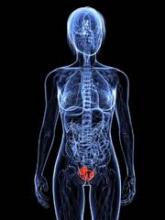A DNA methylation marker panel from urine sediments was superior to gold standard tests for predicting recurrence of bladder cancer, investigators reported April 1 in Clinical Cancer Research.
Eighty percent of patients with positive scores on the three-marker panel developed recurrent, biopsy-proven urothelial carcinoma after complete resection of the visible primary tumor (95% confidence interval, 62%-98%), reported Dr. Sheng-Fang Su of University of Southern California Norris Comprehensive Cancer Center, Los Angeles, and his associates.
The panel’s positive predictive value far exceeded the values for cytology (35%; 95% CI, 14%-56%) and cytoscopy (15%; 95% CI, 0-31%), the investigators reported (Clin. Cancer Res. 2014 [doi:10.1158/1078-0432.CCR-13-2637]).
The prospective study enrolled 90 patients who had undergone transurethral resection of noninvasive urothelial carcinomas (Tis, Ta, T1; grade low high). Median age of patients was 69 years (range, 41-96). Patients with high-grade Ta/T1 tumors had received intravesical Bacillus Calmette-Guerin vaccine or mitomycin C at their physicians’ discretion.
The investigators performed cytology and extracted DNA from 368 urine and bladder wash specimens collected from patients over a seven-year period. Patients also underwent cytoscopy. The investigators used logistic regression to assess the sensitivity and specificity of various combinations of DNA methylation markers.
The optimal panel included a tumor-specific hypermethylated marker (SOX1), an epigenetic marker (IRAK3), and a field defect-associated hypomethylated marker (L1-MET), the researchers said. The panel’s sensitivity was 80% (95% CI, 60%-96%) and specificity was 97% (95% CI, 91%-100%), they reported. The negative predictive value of the panel (74%) resembled that of cytoscopy (80%) and cytology (76%), they said.
Dr. Su and his associates noted that previous marker tests were more sensitive than cytology, including the FDA-approved NMP-22, ImmunoCyst, and UroVysion tests. But these are expensive, labor-intensive, less specific, and benign urinary conditions can compromise their reliability, they added.
A panel like the one used in the study could help clinicians determine the appropriate frequency of follow-up cytology after bladder cancer resection, the investigators said. But they noted that the validation sets were not ideal and that the urine markers should be further explored in a larger, independent cohort.
The National Cancer Institute funded the research. One of the researchers, Dr. Jones, reported having been a consultant and advisory board member of Astex, Lilly, and Zymo. The other authors reported no conflicts of interest.

